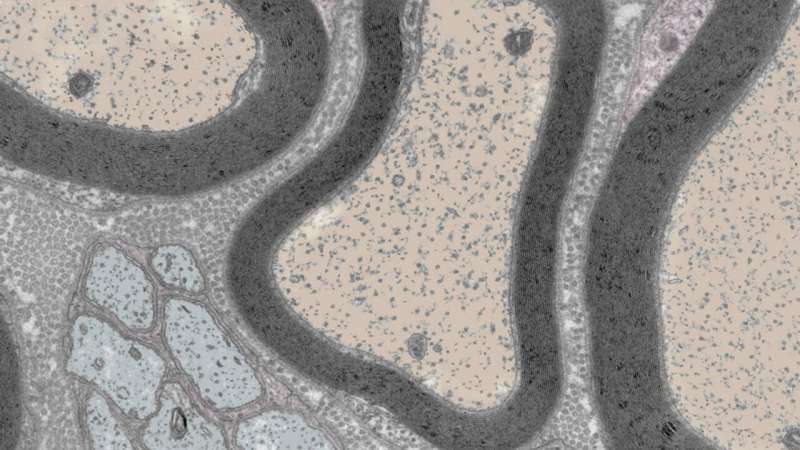This article has been reviewed according to Science X's editorial process and policies. Editors have highlighted the following attributes while ensuring the content's credibility:
fact-checked
peer-reviewed publication
trusted source
proofread
Repairing nerve cells after injury and in chronic disease

Each year in the United States there are more than 3 million cases of peripheral neuropathy, wherein nerves outside of the brain and spinal cord are damaged and cause pain and loss of feeling in the affected areas. Peripheral neuropathy can occur from diabetes, injury, genetically inherited disease, infection, and more.
Salk scientists have now uncovered in mice a mechanism for repairing damaged nerves during peripheral neuropathy. They discovered that the protein Mitf helps turn on the repair function of specialized nervous system Schwann cells.
The findings, published in Cell Reports , have the potential to inspire novel therapeutics that bolster repair function and heal peripheral neuropathy.
"We wanted to know what mechanisms control damage response in peripheral nerves under varying conditions—like acute trauma, genetic disorders, or degenerative diseases," says senior author Professor Samuel Pfaff. "We found that Schwann cells, which are special cells in nerves that protect and support neurons' axons, enter their repair state because of a pathway mediated by the protein Mitf."
The peripheral nervous system is made up of all the nerves that branch out from the brain and spinal cord to give us sensation throughout our bodies. There are many cell types in peripheral nerves, but Pfaff and his team focus on understanding neurons, which transmit information throughout the nervous system, and Schwann cells, which protect healthy neurons and repair damaged ones.
The peripheral nervous system's ability to repair damage is remarkable considering that the central nervous system—made up of the brain and spinal cord—is not able to repair damage. Yet, the mechanisms that orchestrate this feat have remained poorly understood.
To unravel how Schwann cells differentiate to begin repairing peripheral nerve damage, the researchers looked at mouse models of Charcot Marie Tooth disease (CMT), a type of hereditary neuropathy.
"Going into this project, I thought that when you have a genetic nerve degeneration disorder, cells are dying and recovery isn't possible," says first author Lydia Daboussi, a former postdoctoral researcher in Pfaff's lab and current assistant professor at UC Los Angeles.
"But our findings show that there are gene programs turned on by Mitf that repair some of the damage done in those chronic disease scenarios, and when you turn those programs off, disease symptoms get worse."
In mice with CMT, the researchers noticed that the Schwann cells completing the repairs had high levels of Mitf in their nuclei—where the genetic instructions for how to be a Schwann cell and how to conduct repairs are stored.
Upon investigation of this relationship between Mitf and Schwann cells, they found that Mitf was in the cytoplasm of Schwann cells until sensing neuronal damage. Damage then prompted Mitf to relocate from the cytoplasm of the cell to the nucleus, where it would direct the Schwann cell to make repairs.
To validate the importance of Mitf in creating repair Schwann cells, the researchers removed Mitf altogether. In cases of both trauma and CMT, nerve repair was arrested in the absence of Mitf—demonstrating that Mitf is required for peripheral nerve repair and regeneration.
According to Daboussi, Mitf acts like a fire extinguisher. Always there, sitting in the Schwann cell, unnoticed until damage occurs. And when that damage occurs, Mitf is ready to go and immediately turns on the cell's repair functions.
Most surprising, noted Pfaff, was that Mitf was orchestrating these repairs during a chronic disease like CMT.
"Harnessing Schwann cell repair programs has great potential in treating chronic diseases," says Pfaff, also the Benjamin H. Lewis Chair at Salk. "It's possible that with targeted therapeutics, we can prompt more Schwann cells to repair peripheral nerve damage and push those repairs to completion in chronic cases. Furthermore, now that we have a better grasp on the repair mechanisms, we can see if it's possible to initiate repairs in the brain stem and spinal cord, too."
In the future, the researchers want to look more specifically at diabetes neuropathy—the most common peripheral neuropathy condition. They also hope to explore therapeutics that bolster this repair pathway to create more Schwann cells programmed to repair damage, regardless of if the source is trauma, genetics, or development over time.
Other authors include Giancarlo Costaguta, Miriam Gullo, Nicole Jasinski, Veronica Pessino, Brendan O'Leary, Karen Lettieri, and Shawn Driscoll of Salk.
More information: Lydia Daboussi et al, Mitf is a Schwann cell sensor of axonal integrity that drives nerve repair, Cell Reports (2023). DOI: 10.1016/j.celrep.2023.113282


















